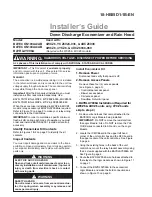
66399-YIM-C-0405
74
Unitary Products Group
9.
If the thermostat and UCB are properly wired,
replace the UCB.
10. If the blower motor runs with the fan switch in the
“ON” position but does not run shortly after the fur-
nace has ignited when the fan switch is in the
“AUTO” position, check the room thermostat for
contact between R and G during “W1” calls.
On calls for heating, the supply air blower operates but
the draft motor does not (the room thermostat fan
switch is in the “AUTO” position).
1.
The draft motor has inherent protection. If the
motor shell is hot to the touch, wait for the internal
overload to reset.
2.
If the motor shell is cold with the room thermostat
calling for heat, check if 24 volts is present at the
room thermostat but not at the UCB, check for
proper wiring between the thermostat and the
UCB, i.e. that the thermostat “W1” terminal is con-
nected to the “W1” terminal of the UCB, and for
loose wiring.
3.
Check if the Draft Motor Control (DMC) is not
pulled in, check for 24 volts at the DMC terminals
“G” and “C”. If 24 volts is present, replace the
DMC. If 24 volts is not present, check for a loose
24 volt connection back to terminal “H1” on the
UCB.
4.
Check if line voltage is present at the DMC termi-
nals “COM” to “NO”. If the line voltage is present
replace the DMC. If line voltage is not present
check voltage from terminal “L3” of M1 contactor to
terminal “NO” on the DMC, if line voltage is present
replace the draft motor.
The draft motor runs but the furnace does not light and
the sparker does not spark.
1.
The ignition control (IC) may be locked out due to
either a flame roll out or 100% shut off. These
safety features are described above. If lock-out has
occurred, 24V must be removed from the ignition
controls. This is done at the unit or by resetting the
room thermostat. After resetting 24V, check for
proper furnace operation. If lock-out continues to
occur, locate the source of the problem and cor-
rect.
2.
Check all 24 volt connections from the UCB to and
in the gas heat section. Check low voltage connec-
tions to the relay (RW1) located in the control box.
3.
If the furnace is hot, it may be out on an over-tem-
perature condition, wait for limit reset.
4.
If the furnace is cold, check for 24 volts at terminal
“5” and “7” of RW1. If 24 volts is present, check the
RW1 relay coil terminals “A” and “B”. If 24 volts is
found at the coil replace the RW1 relay.
5.
If 24 volts is not present at terminals “5” and “7”
and the RW1 relay coil is pulled in. Check for 24
volts from terminal “5” to “Ground” on the RW1
relay. 24 volts here indicates that the problem is in
the (RS) Roll Out Switch, or the (CS) Centrifugal
Switch.
6.
With the draft motor running, check for 24 volts at
terminal “TH” to “Ground” on the ignitor control (IC)
where the red lead from the draft motor attaches. If
24 volts is not present, the centrifugal switch (CS)
has not closed or has gone bad. Check the line
voltage to the unit, if it is correct replace the draft
motor. If line voltage is low call the power company.
7.
If 24 volts is present at the ignitor control, check all
control wiring at the ignitor control and the wire to
the ignitor. Check that the ground wires from the
ignitor control, the gas valves and pilot burners are
all intact and making good electrical connection.
Check to make sure that the ceramic insulator on
the pilot ignitor or sensors is not broken or cracked,
if all are intact, replace the ignition control IC.
The draft motor runs and the ignitor sparks at the pilot
burner but the pilot does not ignite and a gas odor is
not detected at the draft motor outlet.
1.
Check to make sure gas is being supplied to the
unit. Make sure that the gas pressure to the unit is
within the proper limits as described in the “POST
START CHECK LIST” on page 68 and that the pilot
adjust screw is allowing some flow of gas as
described in “PILOT CHECKOUT” on page 69.
2.
Check all wiring between the ignitor control and the
gas valve. Check to make sure the ground connec-
tions are intact.
3.
If the wiring is intact, check for 24 volts across ter-
minals “PV” and “GROUND” on the ignitor control.
If 24 volts is not present, replace the ignitor control.
4.
If 24 volts is present, remove the pilot burner and
remove the pilot orifice from the pilot burner. The
orifice is removed in the direction opposite the flow



































